The Siberian Husky is a magnificent breed of dog that is known for its intelligence and athletic abilities. We have become friends with quite a few husky parents, and talented Talent Hounds trick dogs like Maya the Husky and rescues. We love featuring them. We even made Husky Cupcakes in our Dog Licks Recipe Series.
Research “Husky” In Our Breed Library and add your stories, insights, tips and photos.
I caught up with husky parent and fellow blogger Cathy Armato of Dogs Luv Us and We Luv Them at Blog Paws and I heard about a wonderful Therapy Pet organization she works with Pet Partners. Today we are thrilled to feature a Guest Post from Cathy about her Husky Dog Icy and Therapy Work.
Therapy Dogs Make a Difference- Guest Post by Cathy Armato
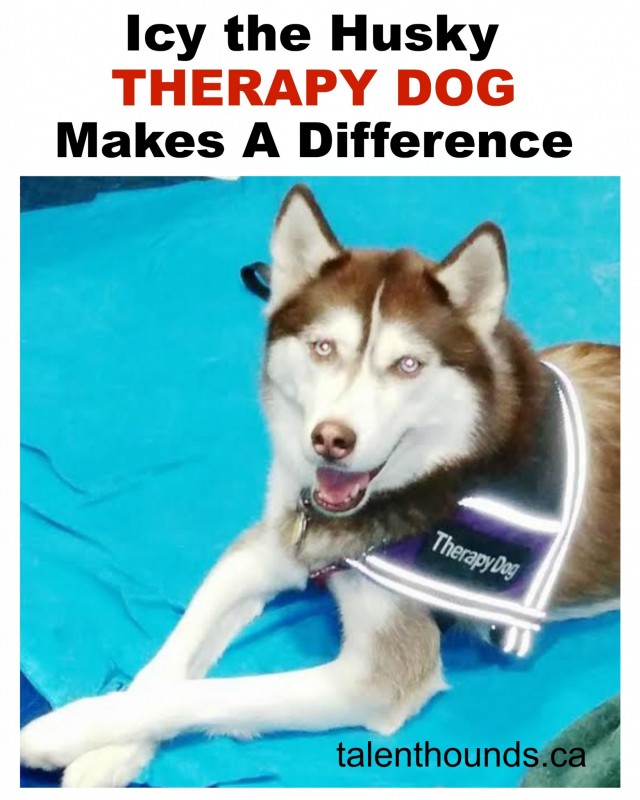
“Working with my Therapy Dog, a Husky named Icy, to help people in our community is one of the most enjoyable and rewarding things I’ve ever done.” says Cathy.
Therapy Dogs help people in many different ways. They help children improve their reading skills and offer comfort and affection through visits to schools, universities, emergency disaster sites, hospitals, nursing homes, seniors residences and other facilities. An individual who is homebound and feeling lonely can benefit from the comfort and smiles offered during a friendly visit from a Therapy Dog as well.
According to Pet Partners, a leading Animal Therapy organization, research shows that positive interactions with animals increase endorphins, oxytocin, prolactin and dopamine. These are the hormones associated with blood pressure regulation, pain relief, stress relief, and joy. So there is actually some science behind the effectiveness of spending time with a Therapy Animal. The majority of Therapy Animals are Dogs, but there are also Therapy Cats, Therapy Rabbits, Therapy Horses, and I know of at least one Therapy Llama!
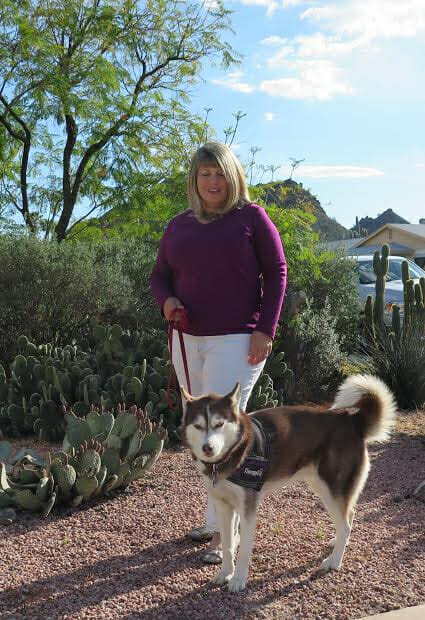
Therapy Dogs Vs. Service Dogs
Many people think a Therapy Dog performs the same function as a Service Dog, but they are quite different. A Service Dog is specially trained to provide one on one assistance to an individual with a disability or other medical condition that requires the dog’s assistance in their daily activities. This would include a Seeing Eye Dog, a Seizure Alert Dog, or a dog assisting a Veteran suffering from Post Traumatic Stress Disorder (PTSD). A Service Dog is usually recommended and prescribed by a medical professional and specially trained and qualified.
Click to See the heartwarming video on the what happened when this little boy with autism got his service dog NSD Chester.
I had read about the wonderful work being done by Therapy Dogs and always loved the idea of it. Years later, when my husband and I got Icy, right from the start she had that rare gentle, sweet disposition. A few months after bringing her home I was so delighted with how good she was with people and other dogs I began to think she would make a good Therapy Dog.
A good therapy dog needs to be friendly and have a gentle temperament. They need to be well socialized and have good basic obedience skills as well. Icy naturally had a great temperament, we just needed to work together to develop her socialization and obedience skills.
Therapy Dogs should be registered with an organization that registers and supports Animal Therapy teams. Most facilities that Therapy Dogs visit will require you to be registered or affiliated with such an organization. Icy and I are registered with Pet Partners, but there are other organizations that can register teams.
Once I decided to pursue becoming a Therapy Dog team with Icy, I enrolled in a training class to help us prepare for the Pet Partners Therapy Dog evaluation. I had to go through a training class myself for the Handler portion of the evaluation and then Icy and I were evaluated together. Some of the things we were evaluated on were:
- Having a reliable Come When Called
- Handing the leash to the evaluator and walking away, out of the dog’s site for 3 minutes. Your dog must not whine or behave anxiously
- Greeting a friendly stranger. Your dog must not lunge at the person, jump up or bark
- Greeting a “neutral”, or friendly, dog. Your dog must not react to the other dog; not try to play, not behave aggressively, bark, whine or jump on the dog or the dog’s owner
- Must be able to walk calmly through a group of people and not react with fear or aggression
Each Animal Therapy organization will have slightly different requirements, but these are the more common ones.
Dogs must be at least a year old to become a therapy dog. Any breed or type of dog can become a therapy dog, it’s more about their individual temperament, personality and behavior.
Helping Children Improve Their Reading Skills
We participate in several different types of programs in our community. I was always an avid reader as a child, so it’s no surprise that one of my favorite Therapy Dog assignments is always the children’s Reading program. This is a program where children read out loud to dogs! Reading aloud helps improve a child’s reading skills and is particularly beneficial to kids that struggle with reading. Many children who are not good readers avoid reading in class and even at home. In this program, kids usually read one on one to a dog with the Therapy Dog handler close by. This gives them a safe, non-judgmental environment in which to read. No one is grading them, judging their reading, or making fun of their reading skills.
When I researched this I learned that:
- Reading aloud helps children improve their reading skills significantly.
- Reading to dogs can help a child build confidence without fear of judgment or embarrassment by parents, teachers or other kids.
- The Dogs help motivate reluctant readers who don’t like to read, or are afraid they won’t read well.
- Reading programs can take place at libraries, schools, bookstores, hospitals, and homeless shelters.
According to the US Department of Education, nearly half of the nation’s unemployed youth aged 16-21 are functionally illiterate, and will have little to no job prospects. Children who haven’t developed basic literacy skills by the time they enter school are 3 to 4 times more likely to drop out later. Those are some scary facts!
Teaching Kids About Kindness To Animals and Therapy Dogs
The kids love the reading program and so do the dogs! They always laugh when Icy demands belly rubs from everyone she meets. They love when her expression shows that she’s enjoying their reading and likes the book they chose to read to her! Sometimes she even closes her eyes and dozes off a bit, like they’re reading her a bedtime story. It often seems like the parents enjoy it even more than the kids, petting the dogs and asking questions about them while their child is reading!
Another assignment I really enjoy is when we get to meet groups of kids and talk about how to properly care for a pet and the importance of being kind to animals. Teaching kids how to properly care for pets and be kind to animals helps build compassion and empathy. We also talk to them about Therapy Dogs and how they can help people in need.
It’s always a lot of fun talking with kids, you never know what they’re going to say or what questions they’ll come up with! Recently, when speaking to a local Girl Scout troop some of the questions the girls asked were:
“Does your therapy dog help blind people cross the street”?
“How do you know if a dog is sick”?
“What is a puppy mill”?
That last question was a bit awkward, but I did my best to explain it without upsetting the girls! I was happy to see such keen interest and good questions from a group of 10-year-olds.
Visiting People With Alzheimer’s
We have also visited seniors in a local nursing home. There is an Alzheimer’s unit in the nursing home and we were asked to visit with residents there. It’s interesting when an Alzheimer’s patient can’t remember the names of family member’s, but they can remember how to interact with a dog. They’ll instinctively pet Icy, ask her name, what kind of dog she is, and say something about her beautiful blue eyes. As they pet Icy, many times they’ll start talking about a childhood dog, recounting details about the dog’s name, breed and personality! When your loved one is in the later stages of Alzheimer’s disease, you grasp on to any signs of “normalcy”. I know because I just lost my own Mom to Alzheimer’s this year. The moment’s when your loved one interacts in a meaningful way and comprehends what is going on around them, or when something makes them smile and laugh it means so much. You hang on to those precious moments and hope for more of them.
Stepping Out Of My Comfort Zone
Recently, I was asked to make a therapy dog visit I wasn’t quite prepared for. It was a little out of my comfort zone, simply because I didn’t know what to expect and hadn’t had any experience with this type of environment. I was asked to visit a United Cerebral Palsy facility that has daytime programs for adults with Cerebral Palsy. Many of these folks are unable to care for a pet of their own at home so they really enjoy visits with therapy animals at the center. They had an animal therapy program but only with small animals, never dogs. They had been asking the staff if they could have a dog visit, so they reached out to me. I was a little nervous but I really wanted to bring Icy for a visit, I was sure they’d love her. It was very different from any of the other programs we’ve participated in. The clients had varied levels of abilities; some appeared to have very minor disabilities while others needed a lot of help to function. Some were in wheelchairs, some had walkers, and a few didn’t have either.
Icy and I sat at the front of the room with everyone around us in a giant circle. We were introduced and I said a few words about Icy; what kind of dog she was, that she loved fish and peanut butter (they all giggled at that!), and that like most Huskies she had boundless energy!
The Coordinator then asked if they’d like to ask me any questions about Icy. A few of the folks had some questions about her and some wanted to tell me about dogs they had themselves at one time. They were really interested in her and they were so sweet to us! One of the teams had actually baked her some cookies, which she of course loved! I was really touched by that, it was so nice of them to make a project out of baking cookies for Icy to welcome her to the center! It ended up being a great visit, and I’m delighted to say that we’ve been invited back to visit on a monthly basis!
Being a Therapy Dog handler and helping people in need throughout my community gives me great joy. Icy loves is too! If you’d like to learn more about Therapy Dogs, or if you’re interesting in becoming a Therapy Dog team, visit the Pet Partner’s web site at www.petpartners.org

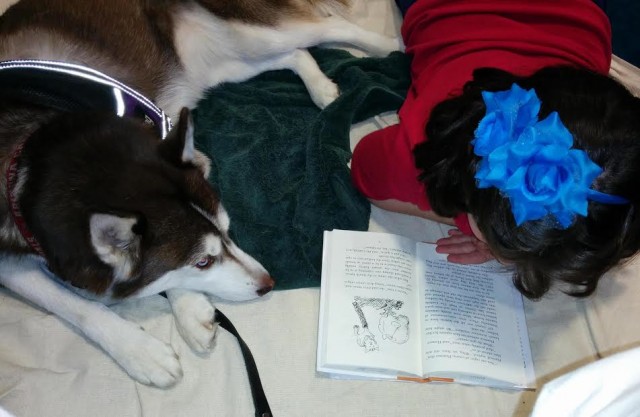
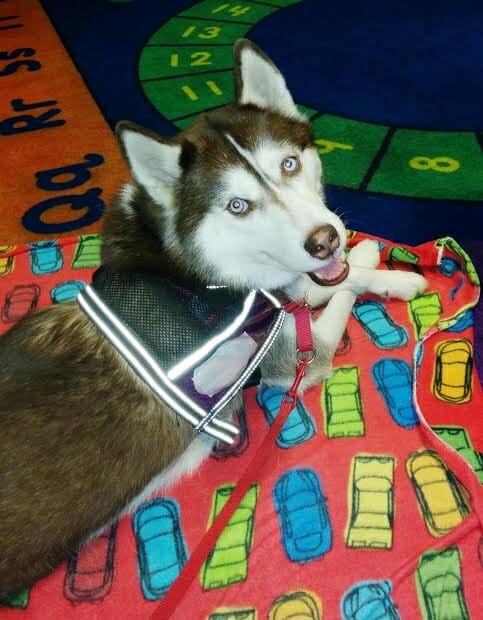
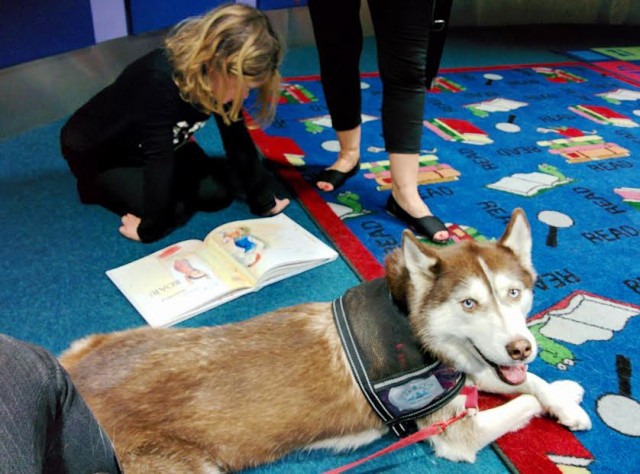
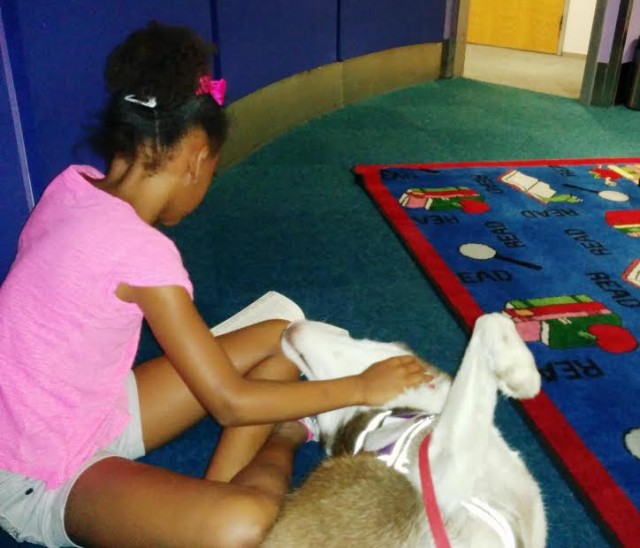
I had a wonderful husky for 13 years. I would love to rescue another one and learn how to
Have him or her become a therapy dog. What do you recommend I do to explore this. Thank you
I think it would be wonderful to rescue a husky. Then you need to see if they have the temperament for being a therapy dog and do a lot of obedience training and socialization. If they love strangers and attention and seem like a good fit, see if there is an organization in your area doing something you might both enjoy. Some dogs love children and reading programs, others prefer seniors, some are fine in hospitals. Good luck- let us know your progress.
This inspiring story emphasizes how therapy dogs like Icy can make a meaningful difference in people’s lives.